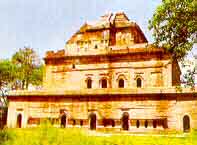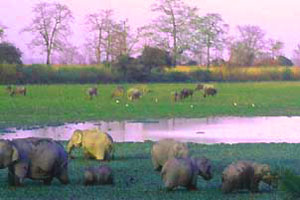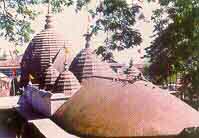| Destinations
|
|||
Assam is the gateway to the North-East. Located between 90 to 96 degrees East Longtitude and 24 to 38 degrees North Latitude, Assam is dominated by the mightly Brahmaputra river that has its origins in Tibet. Indeed, a large part of the state is located in the narrow valley that the river has created over the ages. The state's population include a startling mix of Dravidians, Aryans and Tibeto-Burmese.
Guwahati - your starting point Guwahati has several places of historical interest. Perhaps the biggest attraction is the Kamakhya Temple atop Nilachal hill, where the Goddess Kamakhya is worshipped. The hill commands a majestic view of the city and the river. The ponds here are home to giant turtles which are quite used to being fed by visitors. Another temple which draws people is the Shiva temple on the island of Umananda. This site is especially busy during the Shiva Ratri festival when pilgrims ply to the island. There are other centres of religious and archaeological interest such as the temples of Nabagraha and Basista as well as of Janardhana. Those who are interested in cruises have a choice of either the regular ferries between Sulkheshwar Ghat and North Guwahati, or the more comfortable vessels of the State Government's Tourism Department. The State Museum is a must for visitors, with exhibits which date to the 7th Century A.D. including stone sculptures and bronzes. |
More on North East • Arunachal Pradesh • Manipur • Meghalaya • Mizoram • Nagaland • Tripura
More about Assam
Travelogues |
||
Day Trips
Sualkuchi is an hour's drive from Guwahati and produces the golden silken thread for which Assam is famous. One can see the silk begin its journey from the cocoon stage, to its unravelling and then to the loom to finally emerge as a saree or the traditional Mekhala Chador, the two piece saree, which women wear on festive occasions.
Madan Kamdev, about 35 kms away, is an archaeological site where erotic sculptures and other stone carvings abound. Shopping Pleasures Excursions
Kaziranga
There are several ways of getting to Kaziranga: you can fly to Jorhat and then drive to Kaziranga, rent a car, or take a bus from Guwahati. The route to this national park, which is full of wetlands and some forests apart from the tall elephant grass, is scenic: one will find men and women fishing in the beels or ponds, children diving into the inviting water on a warm day, coconut sellers hawking their wares by the roadside and boys on buffalo back in paddy fields. In the near distance, the blue hills of Arunachal Pradesh beckon. You will pass the town of Jagiroad, where the Assam Silk Mill has an outlet, and the town of Nogaon. 14 kms. from Nogaon is Bordoa,the birth place of the Assamese saint and reformer, Sankardeva, who led a 16th century revival movement of Vaishnavism. Kaziranga is spread over more than 430 sq. kms. and is the place where one of the last creatures of the prehistoric age, the rhinoceros, lives. the lumbering beasts are easy to spot even from the National Highway which passes by the sanctuary. They are best viewed from atop an elephant and there are early morning elephant rides for tourists which must be booked in advance at the Tourist Centre in Kaziranga. There are jeep safaris as well and these can be organised at the Centre. At the sanctuary, you can sight herds of wild elephants, the massive wild buffalo, huge numbers of deer. The species of deer found here are the hog deer, the bara singha or twelve antlered deer, and the large and stately sambhar. Wild boar abound as do many water birds. Among the migratory species are hornbills, storks, such as the Great Adjutant Stork, and cranes. Sibsagar Other Take a day trip from Sibsagar to Dibrugarh, one of the major tea-producing centres of the subcontinent. Near Dibrugarh are major oil and gas installations. The road to the city is flanked by tea gardens on either side which stretch like carpets of green bushes. Women and men stand in the shade or sun, plucking the leaves at a surprising pace and tossing them into the conical cane baskets they carry on their backs. And in Dibrugarh there are tea plantations even within the city limits. Assam produces most of India's tea and a visit to a tea factory should be included in any itinerary. Jorhat, another major tea producing area, located on the edge of the Brahmaputra, south-west of Sibsagar, is a major cultural centre. Majuli, the world's largest inhabited riverine island, which is revered for its satras or Vaishnavite monasteries, is near Jorhat. It can be reached by ferry. The satras here are significant for Assam because they were set up by Sankardeva, the leader of Vaishnavite revivalism, in the 16th century. Majuli is dominated by the Mishing tribe, which came down from the hills of Arunachal Pradesh many year ago and is the only tribal riverine community in the Assam Valley. Their handlooms are exquisite, particularly the colourful Mirizen shawls and blankets which can be used as wall hangings or even as bedcovers. Tezpur Driving south from Jorhat and then across the Brahmaputra on the Kalia Bhomura bridge, you will come to Tezpur or City of Blood, also known at one time as Sonitpur. A very special sight awaits a visitor to the Circuit House in the early mornings: just a few hundred meters away, as the first rays of dawn streak the sky, the river comes alive slowly with boats and vessels of all shapes and sizes - ferries and barges, sail boats and launches and the ubiquitous small nao, or little boat, seen all along the course of this great river.
A new attraction is the Cole Park, named after a British administrator, which has been recently redeveloped with the participation of local people. About 50 kms. from Tezpur, off the road to Arunachal Pradesh, drive over a dirt track and creaky bridges to reach the Eco Camp, a unique experiment by the Assam Anglers' Association and the state's Forest Department. The Eco Camp is near the Jia Bhoroli river and across the river, on the other side, is the Nameri National Park. The organisers at the Eco Camp can put together a day or part of a day for white water rafting. The scenery is magnificent: forests on either side, snow-capped mountains in the distance and a rushing river at hand. Visitors can do river rafting, with guidance from an expert, and try their hand at casting a line for the elusive, large and threatened golden mahseer, the great fish of these waters. There is an ecological campaign to save the mahseer, so part of the river is protected and fish need to be caught and then released in an effort to stabilise their dwindling numbers. The food at the camp, where visitors live in modern tents, is excellent and on most evenings there is a camp fire with music to brighten the late hours. The Nameri National Park sprawls over from Assam into Arunachal Pradesh. The best way of travelling here is (as at Kaziranga) on elephants. There are no roads inside the park. The thick jungle, with patches of swamp, is home to a variety of animals and birds. Among the animals you can spot are the powerful Mithun or Indian Bison and the rare White Winged Wood Duck, among the most endangered bird species on earth. A short distance on the main road to Tawang is Bhalukpong, the entrance to Arunachal Pradesh, where the police check tourist permits. |
|||
Editor: Romola Butalia (c) India Travelogue. All rights reserved. |
|||
 Hajo, 25 kms West of Guwahati, is the site of the Pua-Mecca mosque, set up by an Iraqi prince who turned preacher and travelled all the way to Assam in the 12th century to spread the Prophet's teachings. Hajo is revered by Muslims and Hindus, for in the town is the Hayagriba Madhava Temple, reached by way of a long stone stairway. At the base of the stairway is a large pond where resides one of Hajo's most famous residents: a giant turtle. The town is also well-known for its bell metal work in plates and serving bowls.
Hajo, 25 kms West of Guwahati, is the site of the Pua-Mecca mosque, set up by an Iraqi prince who turned preacher and travelled all the way to Assam in the 12th century to spread the Prophet's teachings. Hajo is revered by Muslims and Hindus, for in the town is the Hayagriba Madhava Temple, reached by way of a long stone stairway. At the base of the stairway is a large pond where resides one of Hajo's most famous residents: a giant turtle. The town is also well-known for its bell metal work in plates and serving bowls.

 Kaziranga is one of the most visited wildlife reserves of India and figures quite often on the itinerary of the discerning tourist from around the world.
Kaziranga is one of the most visited wildlife reserves of India and figures quite often on the itinerary of the discerning tourist from around the world.
 attractions include the Rang Ghar, the double-storied, oval shaped amphitheatre and the seven-storied, Talatol Ghar, with three underground floors The latter is a palace with two secret tunnels. Joysagar, said to be the biggest man-made lake in the country, is spread over 318 acres of water on the edge of the town. A new addition is the Ahom Museum on the bank of the Sibsagar. It stores artefacts of the rulers, including swords, clothes, manuscripts, goblets and platters. The ancient capital of the Ahoms is Gargaon about 13 kms. east from Sibsagar, where the major draw is the Kareng Ghar, a seven-storied palace built by 18th century architects. Charideo situated nearby, is another old capital which was built by Sukapha, the founder of the Ahom dynasty. There are maidans or vaults for the king and members of royal families here. Travellers cross the Namdang stone bridge, carved out of a single boulder hundreds of years ago, over which a busy highway still runs today.
attractions include the Rang Ghar, the double-storied, oval shaped amphitheatre and the seven-storied, Talatol Ghar, with three underground floors The latter is a palace with two secret tunnels. Joysagar, said to be the biggest man-made lake in the country, is spread over 318 acres of water on the edge of the town. A new addition is the Ahom Museum on the bank of the Sibsagar. It stores artefacts of the rulers, including swords, clothes, manuscripts, goblets and platters. The ancient capital of the Ahoms is Gargaon about 13 kms. east from Sibsagar, where the major draw is the Kareng Ghar, a seven-storied palace built by 18th century architects. Charideo situated nearby, is another old capital which was built by Sukapha, the founder of the Ahom dynasty. There are maidans or vaults for the king and members of royal families here. Travellers cross the Namdang stone bridge, carved out of a single boulder hundreds of years ago, over which a busy highway still runs today.
 Ruins of stone temples and a door frame discovered at Da Parbatia/, about 5 kms. west of Tezpur, date to the 5th and 6th centuries. Other architectural remains include the Agnigarh and Bamuni hills the Bhairavi and Mahabhairab temples, and the twin tanks ofBar Pukhuri and Padum Pukhuri
Ruins of stone temples and a door frame discovered at Da Parbatia/, about 5 kms. west of Tezpur, date to the 5th and 6th centuries. Other architectural remains include the Agnigarh and Bamuni hills the Bhairavi and Mahabhairab temples, and the twin tanks ofBar Pukhuri and Padum Pukhuri